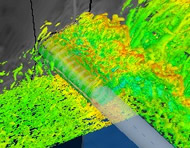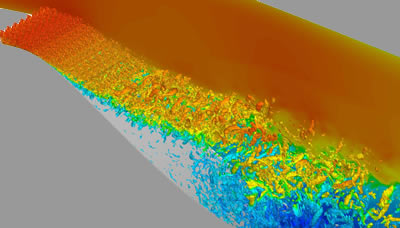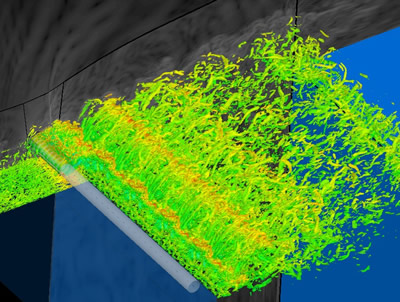Faced with a choice between calculation methods that are simple but limited or methods that are more elaborate but costly, some choose... not to choose. By combining the two approaches, they are attempting to model complex phenomena with the greatest possible precision.
Numéro 36
|
|
Behind the spectacular model of airflow around a wing, turbulence behind a plane, or complex movements of air around the blades of a rotor lie... 'calculation codes'. These methods, based on software engineering, numerical analysis and physical modeling, enable complex calculations to be carried out. "There are two main approaches to taking turbulence into account: statistical calculations and direct calculations", explains Ivan Mary, researcher in the Computational Fluid Dynamics and Aeroacoustics Department at Onera. |
| In statistical methods, the average values for flow and the overall intensity of the fluctuations are calculated without including any information on the frequency with which they happen. Small vortices, which have a significant influence on energy dissipation, are evaluated separately using a scale model. These calculations are rapid and inexpensive, and the information they provide is generally sufficient for industrial clients. Direct methods, on the other hand, which require instantaneous calculations in three dimensions, provide air speed at every point in a very dense grid, including any changes over time. These calculations enable all scales of vortex to be detected as well as the amplitude of the associated fluctuations. They therefore provide a lot more information, although the other side of the coin is that they require greater calculating power, and are therefore time-consuming and costly. This gave rise to the idea of combining the two approaches, in order to carry out calculations that were precise and affordable at the same time. "The idea is to use the direct methods solely where necessary, and to complement them with the statistical methods", the researcher stated. Thus, when the wake noise of an aircraft wing is to be studied, the air movements must be modeled in accordance with the profile of the wing. The direct calculations relate solely to the area downstream of the trailing edge, whereas the area upstream is assessed using statistical methods.
The main difficulty lies in combining the two methods. For example, one method is not time-dependent, whereas the other is. The computational domain involved must thus be divided into two separate areas, and a time-dependence must be ‘created’ at the interface. These ‘mixed’ methods are then validated by comparing them with experiments carried out at Onera in collaboration with a German university laboratory.
This approach also applies to industrial issues. Dassault Aviation is also interested in installing the equipment in aircraft bays, although this raises questions of disturbances when the bay is opened: strong vibrations risk damaging the equipment. Statistical calculations were carried out on the aircraft, complemented by direct calculations for the weapon bay, in order to get a better understanding of these phenomena. Other applications for these calculations in the long term include issues regarding air entry into bent conduits. "In order for a plane to emit less infrared radiation, which makes it detectable, the air entries are not in a direct line with the engine", states the researcher. "The ducts are therefore very bent, but this disturbs flow by creating separation points that risk interfering with the correct operation of the engine. Simulation is very difficult, since the radius of curvature and the pressure gradient create significant separations that it is difficult to simulate precisely using the statistical approach. We try to use direct calculations only where necessary."
Cécile Michaut, journaliste scientifique. |
|






![Etude de tremblement sur un profil d'aile [OAt15 Onera]. La zone aval, siège de l'interaction choc / couche limite est simulée par calcul pour plus de précision](/sites/default/files/actualites/magazine/zoom_in_the_lab/36-decrochage-profil-oat15.jpg)


